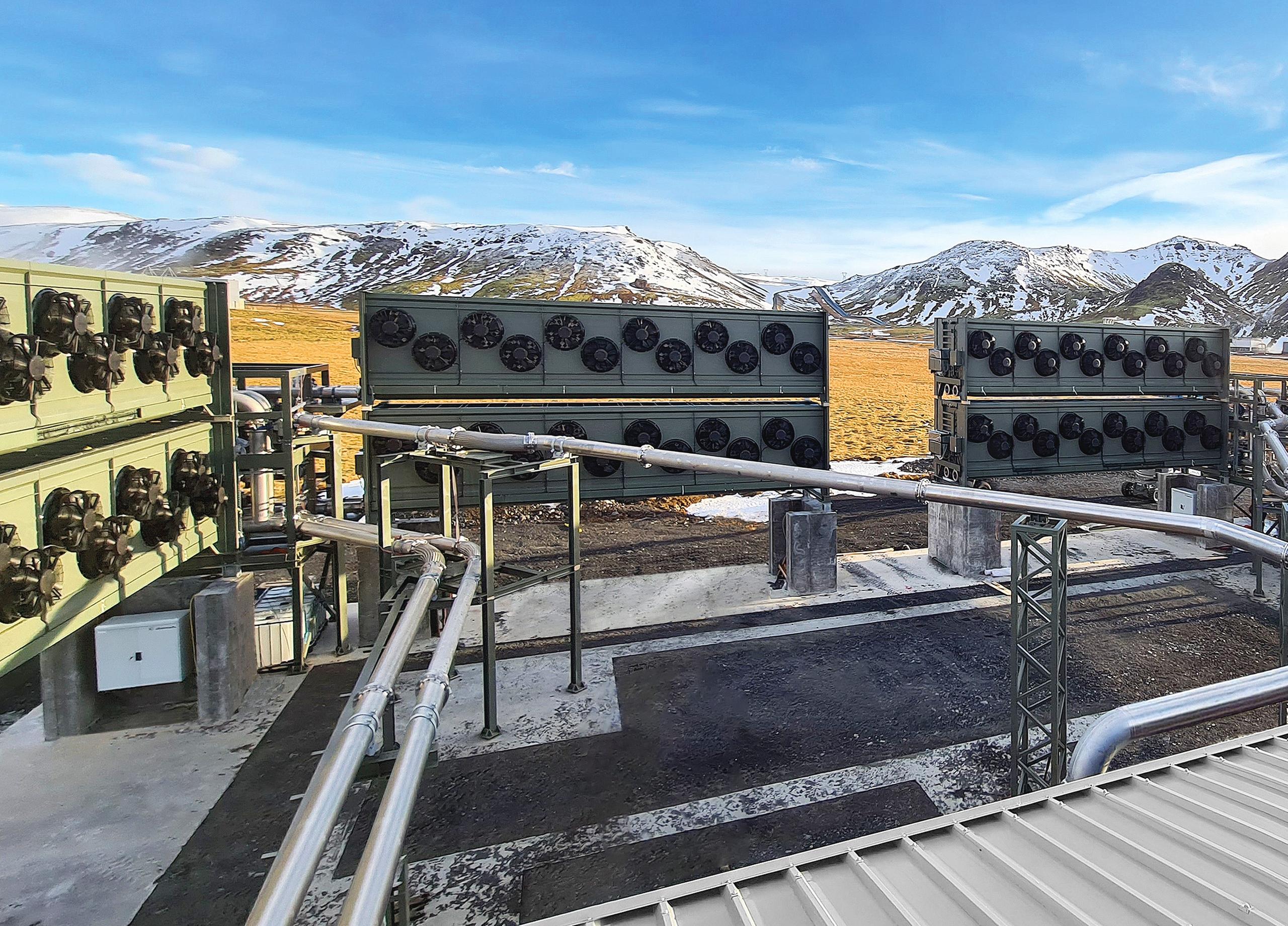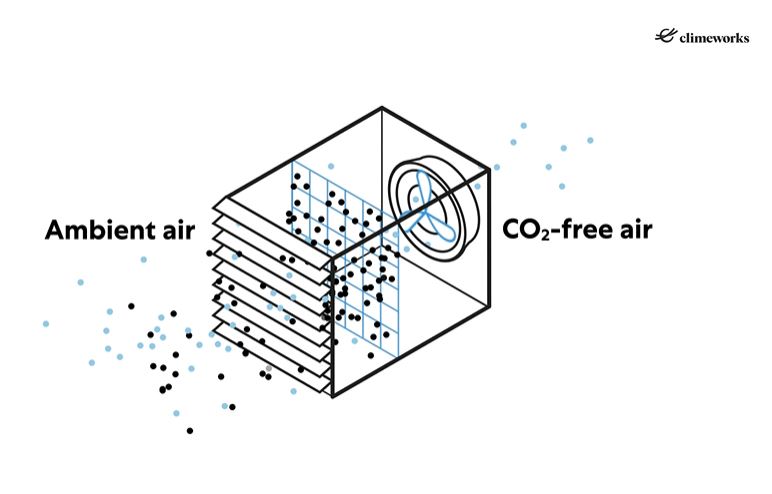
Carbon capture: ‘The road to gigatonne capacity is an ambitious journey’

Removing CO2 from the atmosphere and storing it permanently underground is possible, if challenging. The Swiss company Climeworks assesses progress at its Icelandic facility, Orca, the largest direct air capture (DAC) plant in the world, one year into its operation.
Switzerland is at the forefront of developing technologies aimed at reducing the amount of CO2 in the atmosphere. Exactly one year ago, the Swiss company Climeworks, in collaboration with the Icelandic carbon storage company Carbfix, launched the world’s largest plant capable of filtering carbon dioxide from the atmosphere – called direct air capture (DAC) – and storing it permanently underground.
The International Energy Agency (IEA) and the United Nations Intergovernmental Panel on Climate Change (IPCC) believe that DAC and other CO2 capture and storage technologies are “indispensable” for limiting global warming to 1.5°C and achieving climate neutrality by 2050.
The plant, called Orca, is located near the Icelandic capital, Reykjavik, and is powered by electricity generated by a nearby geothermal power plant. The carbon collectors draw air in through a fan, before it is passed through filters that trap the CO2. The CO2 is then mixed with water and pumped into basalt rock layers at a depth of 800 to 2,000 metres. There it is expected to remain for millions of years.
>> See how CO2 capture and storage work in this short film:

More
Explainer: How to remove and store CO2
SWI swissinfo.ch wanted to know how this work is going now that the plant has been in operation for a full year. Judith Hebekeuser, a spokesperson for Climeworks, responded to our questions in writing.
SWI swissinfo.ch: Orca was designed to filter up to 4,000 tonnes of CO2 a year, equivalent to the annual emissions of 600 Europeans. How many tonnes of CO2 did the plant remove from the air during its first year?
Judith Hebekeuser: Orca is currently in a ramp-up phase, as is standard for first-of-their-kind commercial plants in their first 18 to 24 months in operation. To put it clearly, Orca has not reached its full capacity yet.
Removal capacity is improving continuously, and learnings are being applied at Orca. In June this year, Climeworks announced another ground-breaking facility that could capture ten times more CO2 than Orca.
The biggest takeaway for Climeworks is that our direct air capture process combined with geological storage works as it should.
SWI swissinfo.ch: Iceland’s cold weather forced the plant to temporarily close last winter. How did you fix the issue? Were there any other unexpected malfunctions?
J.H.: Launching a first-of-its-kind facility means anticipating adjustments to real-world conditions. And while teething issues were expected, their exact nature could not have been predicted fully until we started operations. Climeworks’ technology is designed to deliver in all climates. And while tested for Iceland’s cold climate, the plant endured exceptionally harsh climate conditions during its first winter. We could reconfirm the robustness of the technology itself and act on the challenges we faced, which were mostly of a mechanical nature. We had to adjust some parts of the plant due to freezing. For instance, our collector containers are closed by belt drives, which froze due to the low temperatures and horizontal snowstorms. We replaced those belt drives with chain drives.
SWI swissinfo.ch: Climeworks is planning a second, even larger plant in Iceland. Will Iceland become the biggest repository for CO2 emissions or there are other countries or regions, where the conditions are favourable for DAC technology?
J.H.: Iceland is the ideal starting place to get DAC off the ground because it combines the abundant renewable energy provided by ON Power’s geothermal plant and a strong partnership with geological storage expert Carbfix.
Our direct air capture technology can also be applied in other areas where renewable energy and geological storage options are available. About 10,000 to 1,000,000 gigatonnes of total carbonExternal link can be stored in naturally occurring mineral deposits worldwide. We are already exploring other locations with pilot projects in different regions, including Norway and Oman.
SWI swissinfo.ch: DAC plants require a lot of energy, both to power fans inside the collectors and to heat the filters to release captured CO2. How is the energy crisis affecting the further development of DAC technology?
J.H.: Despite the current market conditions, the appetite for permanent and safe carbon removal continued to build up, resulting in solid and steady demand, which is very encouraging.
Our DAC technology is powered solely by renewable energy or energy from waste to maximise our removal impact. This enables us to achieve a 90% efficiency [rate] in capturing CO2 over the life cycle of the plant.
SWI swissinfo.ch: Climate campaigners such as Greenpeace argue that DAC could be a dangerous distraction that could divert attention from the most urgent and efficient action, namely drastically reducing emissions. Why do we have to invest billions of dollars in a technology that can currently remove only 0.0000003% (10,000 tonnes out of 35 billion tonnes) of the CO2 we emit globally each year?
J.H.: Unfortunately, this debate is no longer an either-or debate. We need to do both.
While Climeworks is convinced that carbon reduction must be priority number one, as a tonne of CO2 avoided will always be cheaper than a tonne of CO2 removed from the atmosphere, we must also invest in carbon removal. And we must do it today to meet the capacities required in 2050.
Atmospheric levels of CO2 are too high, causing global warming already today. They will continue to increase in the coming decade as very hard-to-abate emissions (for example, from aviation, cement, and steel) continue to exist, at least [for] the foreseeable future.
SWI swissinfo.ch: Climeworks has ambitious goals: by 2030 you want to reach a total capacity of one million tonnes per year and halve the current price of about $600 (CHF585) to capture and permanently store one tonne of CO2. How do you intend to achieve this?
J.H.: Climeworks’ growth strategy [is divided] into two parts: scaling up in iterations towards a robust multi-megatonne capacity by 2030; then onwards to gigatonne capacity through large-scale global deployment by 2050.
We are aiming [for] a growth rate similar to the one experienced by the wind energy industry. The renewable energy requirement to power DAC facilities is significant and reasonable. Our conservative projections point to adding up to 25GW of wind and solar capacity annually from 2030 onwards. This represents roughly 10% of the installed capacity in 2021, or 3% of the annual capacity projected as of 2030.
Operationally, $30 billion-$50 billion must be invested globally annually into direct air capture from 2030 onwards to build up capacity. This represents 10% of the annual investments made into renewable energy capacity today: it is achievable, and government support, in close cooperation with the private sector, should act as a catalyst [for bringing] this level of investment to life.
The key to lowering costs is industrial scale-up. We expect the cost potential of our current direct air capture technology to be in the range of $250-350 per tonne in the 2030s for a multi-megatonne capacity range. Further industrialisation within the direct air capture ecosystem can realistically reduce costs to $100-200 per tonne in the long term.
SWI swissinfo.ch: Climeworks recently raised CHF 600 million ($650 million) in equity funding and signed long-term carbon removal agreements with Microsoft and banking and insurance companies. What else do you need to do to massively scale up your carbon removal capacity?
J.H.: [The year] 2022 saw significant developments in the DAC and carbon removal industries at large: the United States directed $3.5 billion in funding [towards] the creation of regional DAC hubs across the US and recently brought into law the Inflation Reduction Act, probably the most ambitious climate bill in history, taking DAC and high-quality, permanent carbon dioxide removal momentum to an unprecedented level. The carbon removal industry was further supported by strong commitments from various [individual] and united stakeholders (Stripe’s Frontier Fund, Elon Musk’s XPrize, First Movers Coalition) and has welcomed many new actors and [influencers].
But we also know that the road to gigatonne capacity is an ambitious journey, and we will continue to need all hands on deck: corporate action, investments, policies and regulatory guidelines need to come together to drive the necessary scale-up.
This interview has been edited for length. Edited by Sabrina Weiss/gw

In compliance with the JTI standards
More: SWI swissinfo.ch certified by the Journalism Trust Initiative






























You can find an overview of ongoing debates with our journalists here . Please join us!
If you want to start a conversation about a topic raised in this article or want to report factual errors, email us at english@swissinfo.ch.